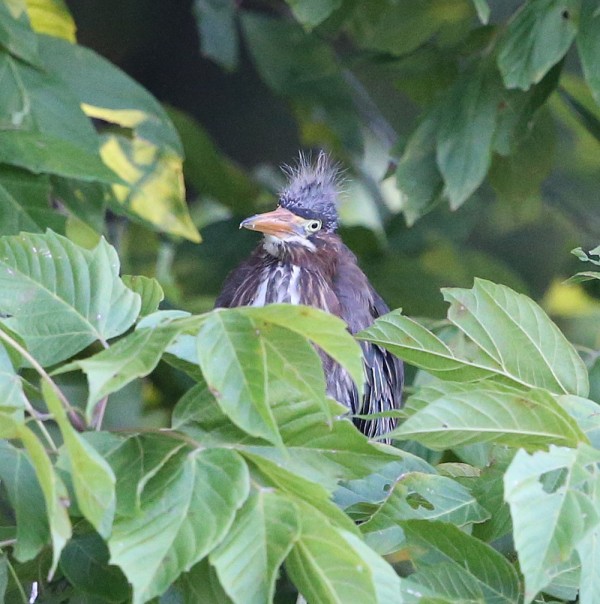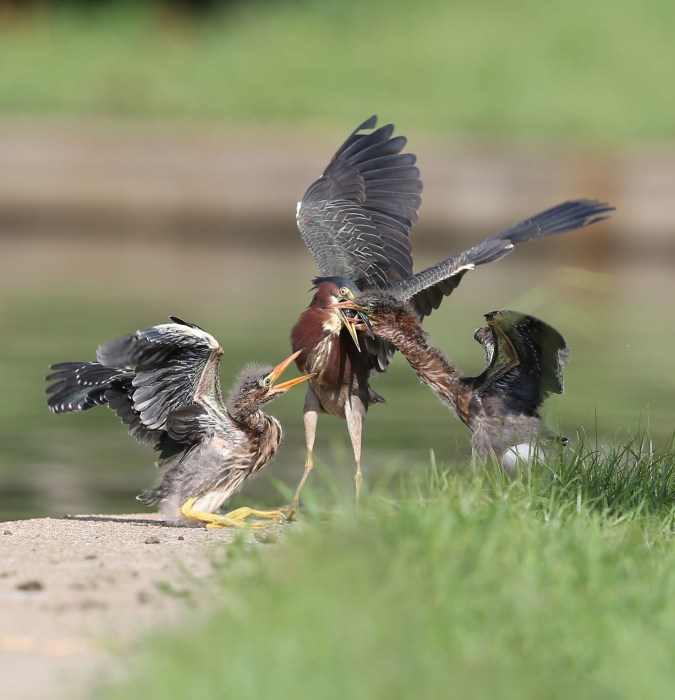Prior to his death in 1801 at Montpelier in Orange County, Virginia, James Madison Sr., the father our 4th president, James Madison Jr., kept a weather journal. He and other family members added garden observations in the margins. According to Hillary Hicks, who wrote “‘A Paradise of Roses’: Flowers at Montpelier,” those observations were recorded as “markers of the changing seasons – blossoming trees, migrating birds, and the progress of fruits, flowers, and vegetables.” Birds are, indeed, markers of the changing seasons. (They are also markers of changing environments.)
Sure Signs
Here’s one sure sign of fall, a newly arrived Blue-gray Gnatcatcher. These birds breed up and down the East Coast, including in the state of Virginia. But many that show up here in the fall are transients, having come from as far away as northern New England (and arriving with thick Downeast accents).

This is another sure sign of fall: a newly arrived Pied-billed Grebe. These birds are transients and winter residents here. This is an immature or an adult in non-breeding plumage. The setting is Lakeside Park in Chesapeake, the site of the Green Heron colony. According to my Audubon Bird Guide App, this species shows up in the fall “in southern states or wherever water remains open.” It had zero trouble finding open water here.

A Photography Aside
I don’t usually like photos of anything moving away from me. I generally prefer side and 3/4 view captures (see “A Photography Aside”). But I like this bird photo.
I like this couple photo, too.

The bird photo captures something of the little bird’s character. The couple photo captures something of a relationship and shared moment.
Always take stock when out there shooting with your camera, but seize every opportunity, even if it means “breaking the rules.” Ansel Adams put it this way: “There are no rules for good photographs, there are only good photographs.”

The Green Heron Colony
The Green Heron Colony. Hopefully, you’ve read the previous 2 blogs posts, which provide many of the colorful details. If you haven’t, you’re not only missing out on those details, but you’re also missing out on Douglas Liu’s photos. Mine seem meh by comparison. That said, I do have a few more Green Heron photos to share.
More Green Heron Photos
Here, it looks as if this young heron had just woken up. However, it’s possible it had been feeding all night. Green Herons are known to forage at night.

It’s unlikely, though, that this or any fledgling or juvenile forages at night. My guess is that they only forage during the day. Also, during the day, they’re still fed at times by mom and dad.

A Discovery
As I was considering this piece, I was prepared to write that all the members of the colony had departed. It seemed as if they had. I joked with a friend that the birds might have caught wind of a pre-Labor Day travel special. I hadn’t seen a “Greenie” in the park since I birded there on 8/29. But I discovered an immature bird there on 9/8. It appeared to be a rather svelte first summer bird (born the previous year).

Fall Migration
Many Green Herons disperse, even north, at the end of the breeding season. The first summer bird above likely flew in from elsewhere, looking for food (and looking to fatten up).
After the birds disperse, they depart most of the eastern U.S. by mid-October. Some will complete their journey as far away as coastal Venezuela.
Imagine with me for a moment. These 3 bewildered-looking fledglings, which I photographed back on 8/9, could very well end up in another hemisphere in 3 or 4 weeks. Doesn’t that boggle the mind? Isn’t it a testament to their skill?

And This Just In
The Pied-billed Grebe is a diving bird and has been called “part bird, part submarine.” Its diet includes its own feathers!
With the help of WordPress, I’ve created a simpler comment form (at the bottom of each post). Please consider leaving a comment. I respond to every one.
Quip, Question, Quote
“The great migrations of the world have been inspiring people for hundreds of years. The migration of birds is particularly fascinating because small species primarily navigate alone, at night, and at high altitudes, so people do not always see it happening. They are in your backyard, and then they are gone.” David Toews, Assistant Professor of Biology at Penn State

We remember the events of 9/11. We remember those who lost their lives 19 years ago today. We remember the families who were left behind.
Noting that birds are markers reminds me of the new word I just learned–phenology, not to be confused with phrenology! My spell check doesn’t even know it, but its the science of the timing of ecological events, as I’m sure you know. By comparing the phenology of birds’ migrations over time, as well as many other phenomena, scientists are learning a lot about the impact of climate change on our flora and fauna. Really interesting!
I love your blog and your wonderful pictures. They add delight and wonder to my days! Thanks!
LikeLike
Wonderful comment, Hank, especially your last few lines. So glad you’re enjoying the blog. Am only familiar with phenology as it applies to breeding, but like you said, it applies to migration, as well.
LikeLike
Thank you for your thoughtful imagery. You have activated the project zero see-think-wonder routine for me as I look at your picture of the three fledgling Green herons. They remind me of the mindset of my students this week, curious and wandering in all directions. You mentioned 9/11 and I thought about discussing the event with them yesterday but instead shared something from the chaotic present as I realized none of my 8th graders had been born in 2000.
LikeLike
Stan, Thank you so much for your thoughtful comment. Am familiar with PZ. Chaotic present, indeed. I taught 6th for a while, so can relate to much of what you said. Kids are kids, be they birds or humans. Do talk with your kids at some point about 9/11, a pivotal day and time in the U.S. in a lot of ways. And there are so many, many ways to explore the topic in the classroom. Keep up all the good work.
LikeLike
It was interesting to read about the season markers in your part of the world Dave. I love that photo of the fledgling heron from behind.
LikeLike
Thanks, Andrea. I love that photo, too, and was fortunate to get it.
LikeLiked by 1 person
👍🤗 Great job as always very interesting information especially about James Madison keeping a weather journal. Also loved the pic of the couple walking away together. Sweet.
LikeLike
Thanks, Kathryn, and thanks for your comment.
LikeLike